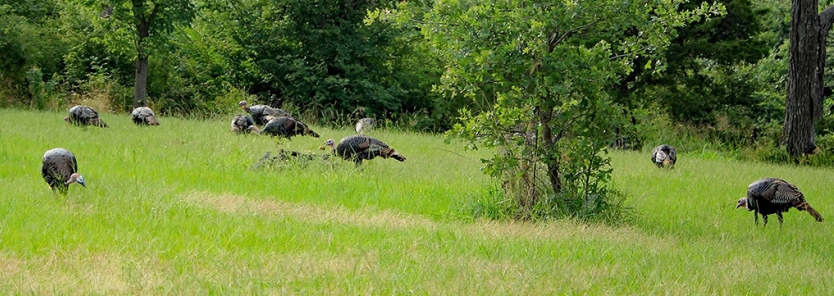Gamekeepers need to study the birds and understand the value of effective scouting. Ideally, anticipating the wild turkeys every move means success in the field. Understanding what turkeys want and then what your farm offers, or lacks, will help you in creating wild turkey habitat. Since turkeys prefer to travel in large numbers during much of the year, creating “social” areas for them to congregate makes sense if such areas don’t already exist.
Dusting Areas
Amidst a turkey’s daily routines is the event of “dusting.” Turkeys love to find areas where the soil is exceptionally loose where they can lie down kick up dust. These areas are hotspots for congregating flocks. Areas along log roads or beneath pine stands are great locations to find a dusting area. You can however create a dusting area with a tractor or ATV.
Simply plowing or disking small strips along natural travel corridors will provide loose soil where the turkeys can then do their dusting. Placing your hunting blinds within shooting range of a dusting site can greatly increase your odds of scoring a tom. Even in times when the toms are locked up with the hens they’ll many times be drawn to the area as they court their dusting dolls.
Wild Turkey Grit
If you’ve ever harvested a wild turkey and examined its crop and gizzard, you likely discovered that they consume gravel and grit to help digest grains and other hard foods. Much like dusting areas, turkeys will typically spend some time each day in an area where they can consume grit.
You can create your own grit or sand area for the turkeys by simply dumping small loads of the material near frequented areas. Obviously, commercial turkey grit used in poultry farming is an easy way to remedy the lack of grit. Otherwise, if you have a river or creek, oftentimes grit can be found along the bank. Grit is an essential need of all turkeys (and other birds).
Food & Watering Areas
We’re simply trying to provide for as many of the wild turkeys’ needs as possible at a given spot. If you add dependable food and a reliable water source, now we’re talking about a turkey paradise. Having a couple acres close where you can rotate some “turkey favorites,” means again, they will spend more time at the spot. There are several preferred food plot corps, but you could add beech, hickory and pine trees along with juniper, dogwood, black cherry, crabapple, grapes and berries as some natural foods that can also be added to the landscape.
Adding certain grass plantings can provide for billions of seeds, excellent bugging habitat and great nesting and escape cover. Native warm season grasses can be difficult to establish and care for in some areas, but even annual grasses like sorghum, numerous varieties of millet, oats, wheat or even corn all produce foods that turkeys love.
Turkeys can go without some other needs, but they cannot go for long without water. If you do not have a creek or pond in the vicinity, a stock tank buried in a low spot or better yet, a Banks water system can work wonders. You want a source that will be available day-in or day-out so the birds imprint on that element and its dependability.








